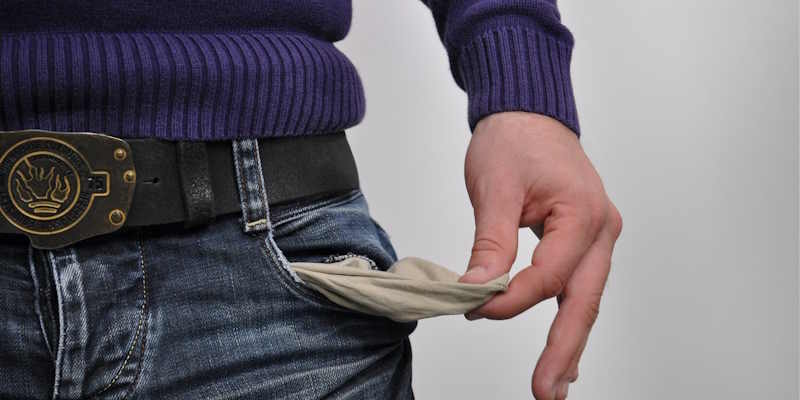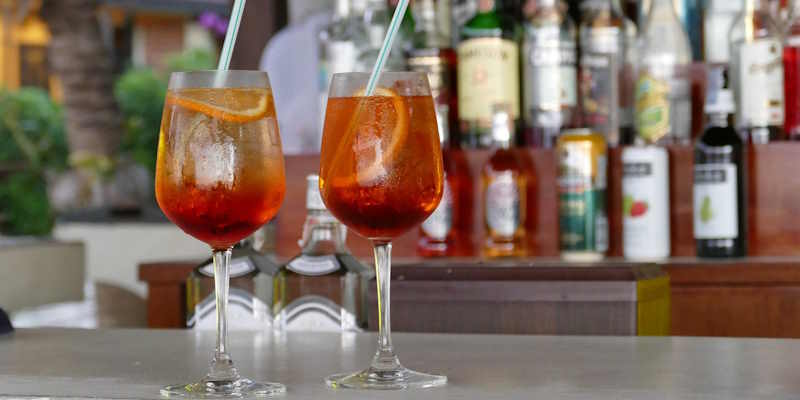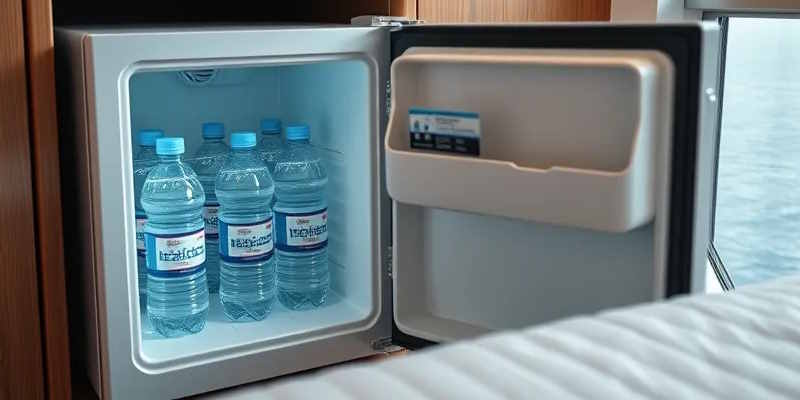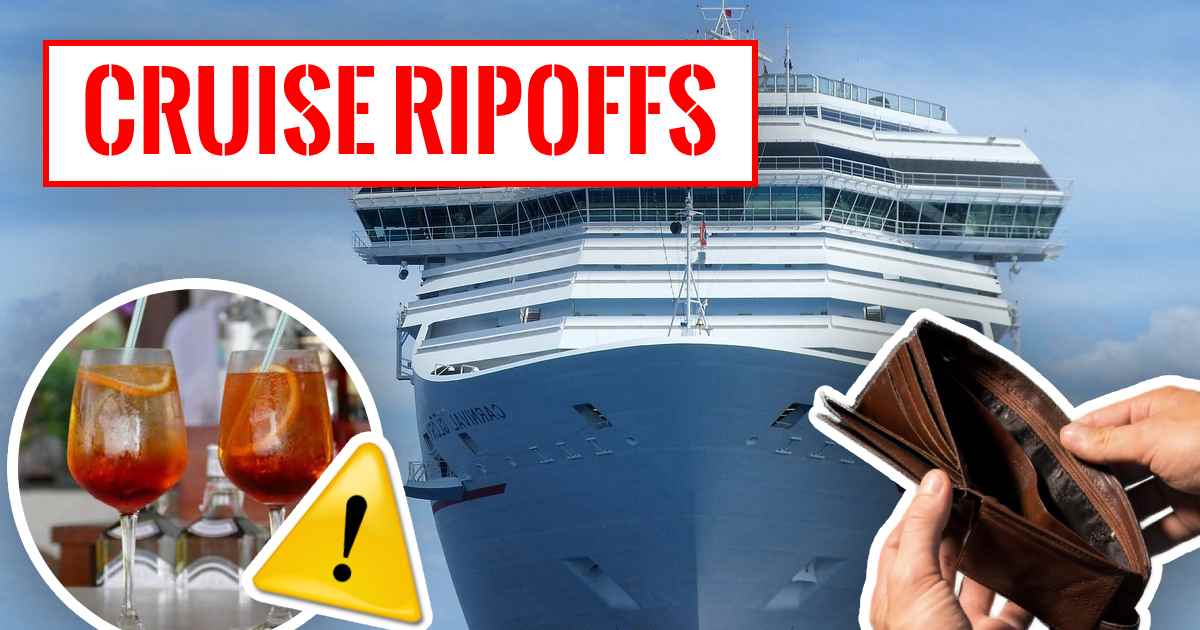Think booking an “all-inclusive” cruise means you’ll never need to open your wallet again? Think again! Cruise lines have mastered the art of emptying your pockets from the moment you board. From overpriced drink packages to exorbitant prices in onboard stores and specialty restaurants, the cruise ship can feel like a luxurious money pit.
How can you avoid the thrill of your dream cruise vacation becoming a nasty shock when you see your final bill? What are the top tips to avoid paying the excessively marked-up prices cruise ship lines charge?
I’ve compiled a list of the top cruise rip-offs passengers complain about. I’ll also share tips from experienced cruisers and my experience on avoiding being ripped off onboard cruise ships.
Top Cruise Ship Rip-offs and How to Avoid Them

Cruise companies give the impression you’re on a carefree, “all-inclusive” getaway. But many unsuspecting cruisers find they end up spending far more than expected. The pricey extras could be miniatures from the mini-bar, paying for lackluster WiFi, or huge markups in specialty restaurants, spa treatments, or souvenir photos.
So, let’s discover classic cruise ship rip-offs that can leave you feeling hard done by when your vacation ends.
Drink packages

Some novice travelers believe the myth that cruises are all-inclusive. However, you must pay extra for some drinks. Beverage packages can be one of the biggest rip-offs on a cruise ship. While the idea of unlimited drinks sounds appealing, you’d need to drink around ten drinks daily to break even. So, if you’re not a heavy drinker, the alcoholic drink package could be more expensive than individual drinks.
Of course, with beers averaging $8, a glass of wine at $12, and cocktails costing $15 to $20—without gratuities—buying drinks at the bar seems a big rip-off anyway.
For some cruisers, the drinks package can be a savvy way to save money. Apart from alcoholic drinks, they usually include specialty coffees, sodas, bottled water, and smoothies. Also, some cruise passengers prefer the convenience of not worrying about tracking up a hefty bar tab.
Calculate how much you’ll likely drink onboard to avoid feeling ripped off by a costly drinks package. Here are two things to remember:
- Cruise port days: Drink packages don’t include buying drinks onshore or on some private islands
- Bring alcohol onboard: Some cruise lines let you bring limited amounts of wine or champagne onboard
Related reading: Things cruise lines won’t let you bring onboard.
Specialty restaurants

Some cruisers feel ripped off by premium dining venues because cruise packages include meals in the main dining room and buffet. You may be shocked to learn that dining in some restaurants can cost over $100 per person. Of course, some are more affordable at around $20 to $30 per head.
Whether you view specialty restaurants as an overpriced add-on depends on your cruise experience. Cruise vacations are memorable, and a special dinner can elevate the vacation. They are also perfect venues for a special celebration to create an unforgettable event. But remember that the food in the main restaurant and buffet is high-quality at no extra cost.
To avoid overspending, many cruise passengers stay clear of specialty restaurants. Or they limit themselves to one or two visits. I’ve also found that lunch menus in specialty dining venues come without a hefty dinner price tag and offer better value for money.
Shore excursions

A common gripe of many cruisers is the exorbitant costs of cruise line excursions compared to independent tour operators. Cruise lines have a long laundry list of port excursions, which is very convenient. But they charge premium prices for the perceived convenience and security of booking with them.
So, do you really want to fork out two or three times the price compared to private operators?
Of course, cruise line excursions offer peace of mind. You usually get priority disembarkation, guaranteed return to the ship before departure, and no hassles with local tour guides. But in my experience, they don’t offer an authentic experience of local cultures.
To prevent spending over budget, consider booking directly with local tour operators. With a bit of research, you can get the best deals. I usually use sites like TripAdvisor and Viator to read reviews and make bookings.
If you’re a newbie cruiser, you may still feel apprehensive about booking independent shore excursions. In that case, look for cruise promotions or discounts before traveling. This way, you can avoid feeling cheated on pricey shore tours.
Onboard WiFi

WiFi packages can be one of the biggest cruise rip-offs compared to your home internet service. While the old per-minute charges, sometimes up to 75 cents a minute, have mostly disappeared, cruisers still find themselves paying hefty prices for onboard internet. Imagine paying the same amount for one day of slow, cruise ship WiFi as you would for an entire month at home.
Cruisers agree that ship WiFi speeds have improved, and you can get deals on unlimited packages. For example, internet connectivity can cost as little as $10 or as much as $35 per day. Depending on the package, you may be limited to social media and text messaging apps. The most expensive WiFi packages allow for video calling.
To save money, avoid using data while onboard and find free WiFi hotspots when in port. Most cafes and restaurants onshore have complimentary WiFi if you buy a snack or drink. Here are a few more tips to save money on cruise packages:
- Purchase an international data package
- Prepay for onboard WiFi to get discounts
- Try an online detox on your vacation
Onboard boutiques and shops

Fancy doing a bit of onboard shopping? If so, expect to pay inflated prices for everyday convenience items, OTC medication, or luxury goods. Sometimes, you can pay twice the typical cost for basic items like sunscreen, toiletries, and snacks.
Onboard shops are exceedingly convenient if you’ve forgotten to pack something. Also, they can be handy places to pick up souvenirs and gifts without leaving the ship. However, don’t make the mistake of waiting until you are on board to go shopping.
To avoid price rip-offs in onboard shops, pack everything you need. If you want gifts or souvenirs, wait until you’re in port. You’ll find more authentic souvenirs and help support the local economy. If you’re considering duty-free, compare onboard prices with port prices to find genuine bargains.
Bottled water

Bottled water must be one of the worst cruise line rip-offs. I checked online, and you can expect to pay $3 to $6 for a large bottle of water. With this extortionate markup, buying several bottles of water will soon add up.
Many first-time cruisers aren’t aware that tap water is freely available from the buffet. Also, bottled water is included in many premium drink packages. So, taking a couple of bottles back to your room is always a good idea.
I always take a refillable bottle onboard to avoid the bottled water rip-off. I also discovered that some cruise lines—Royal Caribbean, Carnival Cruise Line, and Norwegian Cruise Line—have reasonably priced water packages that include delivery to your cabin.
It’s also a good idea to check your cruise package because you may be able to bring bottled water onboard. So, check your T&Cs and plan accordingly, or consider a prepaid water package to stay hydrated onboard.
Mini-bar charges

Charging over the odds for mini-bar items is a classic rip-off hotels and cruise companies love getting away with. If you fancy a tipple from the “complimentary” mini-bar, expect to pay around $10 for miniature liquor or $7 for a beer. Of course, alcohol is where cruise ships make most of their profits.
One of the best cruise tips is to ask your cabin steward to empty the mini-bar. This way, you avoid the temptation of overpaying for alcohol, and you can use it for your own snacks. It’s usually cheaper to buy drinks from the bar and bring them back to your room.
Spa treatments

You’ll find that spa treatment prices are significantly higher than landside prices. Of course, cruising is all about relaxation and letting your worries float away. And you can pamper yourself with luxurious facials, massages, and other salon services. On top of the $200 or $330 you pay to relax, you must pay automatic gratuities.
Honestly, I love getting massages onboard, but I’ve got a few strategies for saving money.
First, I usually spend a port day onboard and take advantage of discounted spa rates. Also, I set up notifications before the cruise for special spa package deals. I also read that some cruisers recommend paying for the thermal spa. It gives you access to all amenities and is valid for the entire voyage.
You must be savvy about another trick cruise lines use to rip you off—upselling beauty products. After your pampering, get ready to say no several times as they try to hard-sell you more products or treatments.
Souvenir photos

Another one on the list of “biggest cruise rip-offs” must be the onboard photographer. Stepping onboard can make you feel like an A-listed celebrity. The cruise ship paparazzi snap you arriving and having fun throughout the cruise. Then, they’ll encourage you to spend $25 or more on the photos.
Of course, photos create lasting memories of your dream vacation at sea. And maybe you want a professional photograph to capture a special romantic moment. Personally, I think they are a needless waste of money.
The best solution is to capture your own memories with a smartphone or camera. Your fellow cruise passengers will also be happy to help. Or, why not purchase a single digital photo of your group from the cruise photographer and split the cost? You’ll receive a high-quality digital image that you can share or print later, which will be much cheaper than buying multiple prints onboard.
Art auctions

Most modern cruise ships have art galleries and artwork auctions are another way they will drain your wallet. Most industry experts agree that cruise ship artwork is not highly valued. Unfortunately, many passengers get caught up in the moment and pay over the odds for the piece.
If you decide to attend the auction, do due diligence as you would before buying any piece of art. Research the artists, check the paperwork, and set a budget. You may pick up a bargain. In any case, you will enjoy the free champagne cruise companies use to lure guests into auctions.
Paid-for onboard attractions

After paying for your “all-inclusive” cruise, you may feel conned when you must pay extra for the newest onboard attractions. The latest cruise ships have go-karts, zip lines, roller coasters, and giant waterslides. Unfortunately, the newest onboard thrills usually have premium price tags attached.
Here’s a list of some of the paid-for onboard attractions:
- Royal Caribbean’s Icon of the Seas: Crown’s Edge, which involves sky walking, ropes and zip-lining
- Carnival Cruise Line’s Carnival Celebration: Bolt Roller Coaster
- Norwegian Cruise Line: Virtual playground, Formula 1 Grand Prix Racing, and go-karting
A cruise is all about having fun and enjoying yourself. So, if you decide to use the attractions, budget accordingly. Also, you may find discounts for the attractions if you stay onboard on port days.
Shipboard casinos

Ship and land casinos are designed to drain your wallet faster than a sinking ship hitting an iceberg. It’s no great secret that the casinos favor the house. And the thrill of winning money is tempting. But if you’re not a gambler and are on a budget, it’s best to stay away from the flashing lights and promises of “ka-ching!”
One experienced cruiser summed up onboard casinos, saying, “Casinos are where vacation budget go to die.” Online rumors abound that machine payouts in shipboard casinos are generally stingier than landside ones.
If you hit the tables or play slots, follow the typical rules: keep bets small and stick to a strict budget. Also, avoid the temptation to chase losses, or your Caribbean cruise budget might get busted.
ATM charges for withdrawing cash

Discovering how much cruise companies charge for onboard ATM fees can be shocking. Expect to pay around $6 per transaction. Of course, it’s not too much if you’re withdrawing a lot of cash. But frequent small withdrawals quickly add up.
The best way to avoid lining the pockets of cruise companies is to bring as much as you need. In many cases, ATMs in port cities charge less or no fees, depending on your card issuer. Or consider using a credit card for extra onboard and onshore purchases.
Laundry services

Laundry services can seem like an expensive rip-off, especially for first-time cruisers. However, I discovered that the costs vary greatly between cruise lines. Some have a per-bag cost, meaning they’ll wash, press, and fold everything in the bag. Other lines charge per item. Some Carnival cruise ships have self-service laundromats.
Sometimes, paying for laundry services is an unavoidable cost on longer cruises. I usually take liquid detergent and wash smaller items in the bathroom sink. One passenger said they typically take a couple of plastic hangers to dry tees.
Medical services

The cost of medical treatment and prices in onboard pharmacies can be high compared to landside medical care. Usually, you must pay for medical services and then submit a claim to your travel insurance. However, ignoring signs of serious illness or infectious diseases is never a good idea.
Always have travel insurance for a cruise to mitigate the enormous costs associated with onboard medical care. Also, take a well-stocked first-aid kit for minor issues like cuts, bruises, and headaches. This way, you won’t have to spend unnecessarily on overpriced band-aids or over-the-counter painkillers from the onboard pharmacy.
Automatic gratuities and service charges

Automatic gratuities can seem like a rip-off, especially when they add hundreds to the cruise cost. However, they help supplement wages for the low-paid crew, and most of us believe everyone should get decent wages. So, most cruisers prepay automatic gratuities when booking the cruise and forget about them.
However, automatic gratuities can seem like a scam for additional services like drinks and spa treatments. I usually tip my cabin steward for fulfilling special requests or bartenders who perform exceptional service.
Solo supplement surcharges

Paying for two people when you’re a solo traveler can make you feel ripped off. Cruise lines charge single people between 50% and 100% for double cabin occupancy. Of course, this is to recoup lost revenue from a second passenger. But still, paying double for a cruise hurts the pocket big time.
Thankfully, some of the newest cruise ships offer single-occupancy cabins, although they’re not always cheaper than a regular double room. To avoid paying extra as a solo traveler, you can look for special deals, travel during off-peak seasons, or find cruises that offer lower or no solo supplements.
Beat the Rip-offs: Discover the Best Cruise Line Loyalty Programs to Save Big!
While cruise ship rip-offs can take a toll on your wallet, there are still ways to save! One great option is to take advantage of cruise line loyalty programs that offer significant perks and discounts to frequent travelers. Explore the best loyalty programs and start saving on your next cruise with these tips.
Related articles:

